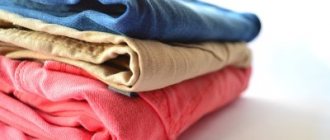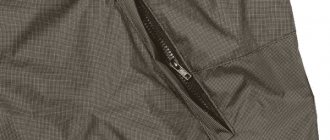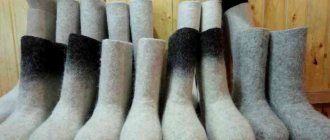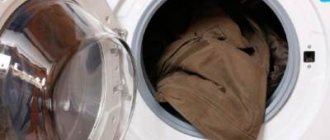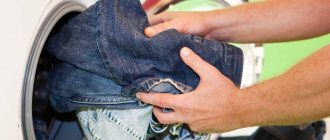Denim is considered a universal outerwear; it goes harmoniously with different styles and is suitable for both hot and rainy weather. It is dense, durable and quite easy to care for - it is washed rarely and in a washing machine. But, being a natural fabric, it inevitably deteriorates if the cycle is not set up correctly. Before washing a denim jacket in an automatic washing machine, you need to know the rules for caring for denim and the manufacturer’s recommendations. Let's tell you everything in order.
How to properly wash a leather jacket?
To clean it, button the jacket and turn it inside out. Cleaning is carried out with a brush with a soap solution or liquid powder. If it is heavily soiled, it is better to take the item to a dry cleaner, where it will be professionally cleaned. You can also take the jacket to a tailor to have the lining altered.
Interesting materials:
What do you need to work in Russia? What does it take to work as a waiter? What does it take to work as a teacher? What does a migrant need to work in Russia? What do you need to know to work as a designer? What do you need to know to work as a freight forwarder? What does the employer pay for the employee? What is the employee's income? What applies to renovation work? What does flexible working mean?
Preparation
Denim can be washed either by hand or by machine. Before washing, the product must be prepared:
- Read the information on the manufacturer's label.
- Fasten all zippers and buttons.
- Check your pockets.
- Turn the jacket inside out.
If you are washing a denim jacket for the first time, do it separately from other clothes and on your hands. To fix the dye, you can add a little vinegar to the water.
Machine washable
Before you begin, fasten the zippers and buttons, check the pockets, and turn the product inside out. Use liquid detergents; they wash out more easily than powder.
Selecting the desired mode
For washing, select the denim cycle. If this is not the case, use a delicate or other gentle mode. Other parameters:
- number of revolutions – no more than 800;
- duration (do not wash a lightly soiled jacket for a long time);
- amount of water (the more there is in the drum, the better).
Temperature selection
- The optimal temperature is 30–40 degrees. In this case, the item is not deformed and its color is preserved.
- Permissible temperature is up to 60 degrees.
Features of ironing jeans
Properly dried jeans do not need ironing. And yet, if strong creases appear, you cannot do without an iron.
- It is almost impossible to iron overdried jeans, so the fabric should be slightly damp. If you do dry out the item, spray water on the item or use a wet cotton cloth.
- Turn on steam mode. Hot moisture will soften the material of the jeans and smooth out hard wrinkles.
- Choose a temperature of about 150–180 degrees. This is the optimal mode for thick cotton fabric.
- Iron from the reverse side of the product to avoid sagging from the hot sole.
- Treat decoratively wrinkled items of clothing with a steam generator.
Wash by hand
To wash denim by hand:
- in a weak soap solution;
- in a straightened form (preferably in the bathroom);
- in a small amount of water at a temperature of 30-40 degrees;
- separate from other things.
For severe dirt, you can use a soft brush.
How exactly to wash a denim jacket - in order:
- Lay out the clothes, apply a soapy solution of laundry soap or liquid detergent evenly.
- Wash each area of the product.
- Rinse in cool water until it runs clear.
- Wring out the jacket, but do not twist it, let the remaining water drain out.
For severe stains, you can soak the item in warm water for no more than half an hour.
Explanation of the label
The manufacturer informs you under what conditions to wash the jacket using symbols:
- container with water and a number - washing temperature;
- triangle - whitening;
- letter in a circle - dry cleaning;
- iron with dots - ironing;
- a square with vertical stripes is a drying method.
The label of a simple denim jacket without lining often indicates a water temperature of 40 degrees. A crossed out triangle means no bleaching. The letter "P" is enclosed in a circle. The symbol indicates that the item is subject to standard dry cleaning. Two dots are placed on the iron, indicating ironing at 150 degrees. Vertical stripes in a square are a sign indicating hanging drying.
How to quickly remove a stain from jeans using specialized products
If you decide to use household chemicals, you need to take a responsible approach to choosing a powder, stain remover or washing gel. A detergent that is too aggressive can ruin the denim, its color and texture.
The most popular household chemicals most suitable for washing denim:
- Ariel powder in capsules. As mentioned above, it is not advisable to clean jeans with ordinary powders. But gels or capsules are ideal. Ariel is one of the most affordable capsule powders. It is capable of removing stains of any complexity from denim fabric.
- Gel Laska not only removes stains well, but also softens the material due to its conditioning effect.
- Flat is a specialized powder intended for denim. It is able to quickly remove stains and not spoil the color of the product.
- Oxygen stain remover Vanish can be classified as “heavy artillery”. It should be used if the contamination is so serious that it cannot be removed with more delicate means.
How to fit a certain area of jeans on the buttocks, hips, knees
There may be a need to shrink the product in a certain area, for example, on the buttocks or knees. For these purposes, a simple and effective method is used.
It is suitable only for those who have the ability to machine dry.
The method is as follows:
- It is necessary to fill the spray bottle with conditioner for washing clothes, diluted according to the instructions.
- The solution is sprayed onto the desired areas of the trousers so that the trousers become damp.
- After moistening, the item is sent to the machine to dry at a temperature of +90°C or more.
Some people use an iron or hair dryer to shrink, but the use of these household appliances, as a rule, does not bring the desired result.
It is possible to return stretched jeans to their original shape or make new ones smaller. Most of the methods listed reduce the size of the entire garment.
Both length and volume are reduced at the same time. This fact is worth taking into account. If the item does not have a reserve of length or width, then it is better to refrain from risky techniques.
Jeans made from 100% cotton are incredibly resistant to any aggressive temperature. Mass worship of universal denim began in the 60s of the twentieth century, and in the first thirty years after the “fashion revolution”, no matter how hard you tried, it was not possible to wash jeans to make them smaller.
Cotton products were not subject to shrinkage even after several procedures of boiling down, which was trendy in the era of the 90s. To soften the tough fibers of denim, manufacturers began to include elastane and lycra in the material. The higher the percentage of a softening additive such as elastane, the easier it is to wash jeans to make them shrink.
What if I wash them in hot water (90 degrees)?
After washing in hot water, jeans will definitely shrink. The higher its temperature, the greater the degree of shrinkage:
- washing at 50-60 degrees shrinks by 0.5-1 size;
- washing at 60-70 degrees reduces jeans by 1-1.5 sizes;
- washing at temperatures of 80 degrees and above leads to shrinkage by 2 sizes;
- The contraction of fabric fibers is enhanced by alternating treatment with hot and cold water.
The values given are average values. The exact numbers depend on the composition of the material, the characteristics of washing and drying the product.
If your jeans have become stretched during wear, this can be corrected by boiling.
Do it as follows:
- Hot water is poured into an enamel basin and brought to a boil.
- Jeans are soaked in boiling water.
- If they float, they are immersed back in using wooden tongs.
- After 5 minutes, turn off the water and leave to cool. To make this process happen as slowly as possible, the basin is covered with a lid.
- When the water has cooled, the pants are taken out and sent to dry.
Boiling colored or black jeans will cause pigment loss. Therefore, only white products can be subjected to this treatment.
Adding shine
To give a fur product a beautiful shine, you can use a weak solution of acetic acid, glycerin or lemon juice. You need to thoroughly treat the fur with one of these products, and then wipe it with a napkin.
In addition, a special product made from fish oil (100 g), ammonia (12 drops), ordinary laundry soap (10 g) and boiling water (1 l) will help to add shine to a fur product. All these components must be thoroughly mixed, then the resulting solution must be cooled to a temperature of 35 degrees and the fur must be thoroughly treated with it. If the fur coat is dusty, then you need to wrap it in a damp sheet and then knock it out.
Dry cleaning
If you cannot unfasten the fur, then it is better to consider ways to clean the fur on a down jacket dry (or using a damp mixture, but without general soaking). It's also easy:
- Mix gasoline and starch until you get a thick mixture with a consistency similar to sour cream. After this, apply this substance evenly to the contaminated area and let it sit. The gasoline will evaporate on its own, after which the pile will need to be combed with a frequent comb to get rid of traces of starch. Please note that this method is not applicable for artificial astrakhan, which may be afraid of gasoline.
- Sprinkle talcum powder over the surface of the collar. Rub it thoroughly with your hands, then shake the down jacket. If a little talc remains, it doesn’t matter, it repels moths. Starch can be used in the same way.
- The above mixture of ammonia and salt can also be used simply for cleaning, without further erasing the edge.
Proper stain removal
Jeans are quite difficult to get dirty. But once a stain appears, removing it can be a problem. If dirt has penetrated deeply into the dense fibers of the fabric, it will be necessary to remove particularly difficult stains before washing.
The easiest option is to use stain removers. There are special products for specific stains. But if you don't have a stain remover, use other products.
An important rule for using any product when removing stains: test it on an inconspicuous area to avoid color washing out and damage to the fabric at the treatment site. So, how to remove different types of stains:
- Fatty and oily substances are washed off with kerosene, white spirit, acetone, and purified gasoline. Dishwashing detergent will also work. Soak a cotton swab or piece of scrap fabric in solvent and gently rub the stain.
- Dye. First, let it dry thoroughly, since a damp stain is almost impossible to remove. Using a sharp object, carefully clean off the dried stain, moving from the edge to the center, and then use a solvent.
- Ink from a ballpoint or gel pen. Soak the stain with an alcohol solution, then rub in regular salt.
- Chewing gum. Put your jeans in the freezer and take them out onto the balcony in winter. The frozen toffee will completely come away from the fabric, down to the smallest particles.
- Grass. A small amount of hydrogen peroxide will not leave a trace of green juice.
Depending on the complexity of the contamination, the item is left for some time with the product applied. Regular dirt comes off well after soaking in water with dissolved powder.
After removing the stain, a long machine wash in warm water is required.
Spin and dry
To maintain the original appearance of the jacket, you must follow some rules:
- Do not wring or wring clothing. Just hang it over the bathtub and the excess water will drain off on its own.
- It is better to avoid spinning and drying in a washing machine, as this can damage the fabric.
- Drying the item with a hairdryer or iron is contraindicated.
- Do not dry denim in the sun as it may fade.
- Don't over-dry your clothes.
- Before drying, straighten out all the creases and tuck the pockets in so you don’t have to smooth them out later.
- Hang your jacket on a line by the sleeves or waistband to avoid leaving marks.
Stretch jeans
Adding synthetic threads to denim has become a necessity. Such fibers increase service life, make the item less susceptible to external influences, and add softness. After tight trousers became fashionable, jeans also began to be made tighter. But the rough fabric still bristled and did not give the desired effect. Therefore, they came up with the idea of adding elastane to jeans so that girls could show off their slender legs in all their glory.
The combination of dense fabric with elastic thread makes stretch jeans indispensable for all occasions, because such clothing hides figure flaws, emphasizing its advantages.
Stretch tolerates washing well, so follow the general rules when cleaning your favorite trousers. And so that over time they do not stretch out on your knees, be especially careful about the spin: it should not be too intense.
Products with stripes, inserts, torn elements
Patches and inserts
To wash jackets with stripes and inserts:
- turned inside out;
- only manually;
- without squeezing (the water should drain by itself);
- using delicate detergents;
- in water with a temperature of no more than 40 degrees.
Torn elements
How to wash jackets with torn elements:
- Hand wash preferred.
- If you decide to use a machine, a delicate mode with a minimum number of revolutions will do.
- Machine spinning and high temperatures are contraindicated.
- Don't forget to turn the product inside out.
- Before drying, carefully straighten the item, returning it to its original appearance.
Denim jackets with fur
- Hand washing is recommended, but you can also use a machine on the delicate cycle.
- Monitor the water temperature and the number of revolutions.
- Do not turn on the spin cycle in the machine.
- The fur should dry on its own, without using an iron or battery.
- Once dry, use a brush to fluff up the fur inserts.
At home, you can only wash faux fur; inserts made from natural fur cannot be washed - you will have to go to the dry cleaner.
Detergent
Can faux fur be washed? Can. Such a product can be processed manually, cleaned using home or professional products. It is better to use specially formulated chemical products designed to remove dirt from artificial pile.
Manufacturers of such products recommend using the following products:
- FLAT;
- VESTAR (washing gel);
- Emsal Tuba;
- Alles Gut;
- Dreft Delicates{amp}amp;Color;
- Luxus Professional;
- Frosch.
All detergents will provide a delicate wash, show good results, retain the shape of the product and protect the color from fading.

